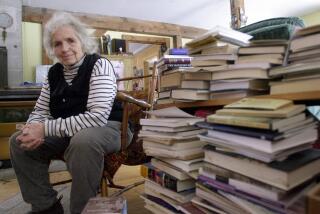THE SHAPING OF A NAZI IN ‘SUMMER’
- Share via
The Goethe Institute’s series of films on the Holocaust continues with Ilse Hofmann’s “The World That Summer,” which screens Tuesday at 7:15 p.m. at Martyrs Memorial and Museum of the Holocaust, 6605 Wilshire Blvd.
On the surface, Hannes Hacker, the bright 12-year-old hero of “The World That Summer,” seems no different from other Hamburg boys captivated by the 1936 Olympics and going on outings of the feverishly patriotic “Jungvolk,” whose members were automatically graduated into Hitler Youth at the age of 14. But Hannes (Jan-Claudius Schwarzbauer) is different, for his mother is Jewish.
Adapted by Robert Muller from his 1959 autobiographical novel and directed by Hofmann with a devastating light, cool touch, “The World That Summer” captures with a convincing authenticity daily life in the Third Reich--and the shaping of Hannes into a little Nazi. It is a time of escalating and virulent anti-Semitism, which has already infected Hannes’ young friends.
Only Hannes’ older sister, whose affair with an alleged Communist proves a further threat to her family, faces their predicament squarely, asking her despairing father why they don’t emigrate to Britain, France or Holland? “The World That Summer,” which is involving nevertheless, was shot in a high contrast black and white, not merely to match deftly incorporated newsreel footage but to convey the harshness of the era. The film series is being presented in conjunction with the Museum’s current Anne Frank Exhibition. For more information: (213) 854-0993.
“Love on the Ground” (at the Nuart Wednesday and Thursday only) finds Jacquette Rivette up to his old games of romantic role-playing and fantasy-reality riddles. Actresses Jane Birkin and Geraldine Chaplin are recruited by playwright Jean-Pierre Kalfon to perform, with Andre Dussolier, in what proves to be an autobiographical play staged, a la “Tamara,” in a vast, partly derelict Grecian-style suburban Paris mansion gaudied up for the occasion. The film is lots lighter than Rivette’s similar “L’Amour Fou” but leaves us feeling, as does his “Celine and Julie Go Boating,” that it’s much ado about little, considering the heavy demands it makes of our concentration. But it does have wit and style, and the actors are a pleasure. Phones: (213) 478-6379, 479-5269.
Among the Orson Welles offerings at the County Museum of Art this weekend are “Chimes at Midnight” (1966), his robust Falstaff pastiche, and his less-seen “Othello” (1951) and “Macbeth” (1948). Welles’ “Othello” is a film of incredible beauty, possessing a dynamic rhythm and dark, fatalistic vision of the world all his own. The dazzling style of this “Othello” is but half of Welles’ superb accomplishment. The other is his own portrayal of the Moor as a sensitive, intelligent man, mortally wounded by the thought of betrayal by his beloved. For full schedule and show times: (213) 857-6177.
More to Read
The biggest entertainment stories
Get our big stories about Hollywood, film, television, music, arts, culture and more right in your inbox as soon as they publish.
You may occasionally receive promotional content from the Los Angeles Times.










